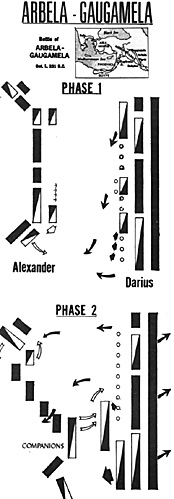 Outnumbered almost three to one, Alexander drew his army
up before that of King Darius of Persia. First he "refused"
his left wing by obilquing his main line 45 degrees. At both ends
of the line he placed cavairy--the greater concentration
being at the refused left. With this done, he marched the
whole formation diagonally towards the left end of the Persian line.
Outnumbered almost three to one, Alexander drew his army
up before that of King Darius of Persia. First he "refused"
his left wing by obilquing his main line 45 degrees. At both ends
of the line he placed cavairy--the greater concentration
being at the refused left. With this done, he marched the
whole formation diagonally towards the left end of the Persian line.
With this order of battle Alexander hoped to draw the Persian cavalry primarily onto his forward right position where hecould easily tie them down. Once having virtually immobilized them, he could then attempt to smash the thin Persian line with his fresh and eager Companion Cavalry units. Further, should the Persians threaten to outflank himontheright, his obliqued left could easily wheel around to form an "all-around defense" much like a square. (British writers in fact often call this oblique order a "grand hollow square.") At first Darius refused the bait. He moved laterally to the left in order to cover Alexander's diagonal advance. This action certainly reveals that Darius had some familiarity with the purpose of the oblique order.
But the bait was too tempting for the ill-fated king. His resolution broke. Onto the right "fist" of Alexander's line he threw 11,000 top-flight Persian cavalry. Moments later he sent another 14,000 across the battlefield to the refused left wing.
In other words he did everything Alexander had calculated he would do! At this point Alexander threw his Companions against the weak centre of the over-extended Persian line. This move sealed Darius' fate. As Alexander rolled up the Persian'line and broke the centre, the left wing of his obliqued line became a "giant fishnet" (E. W. Marsden The Campaign of Gaugamela) scooping up the disorganized remnants of the Persian army. Again the oblique line had proved its worth.
Although Alexander successfully re-used the oblique order against King Porus of India five years later, over the next two thousand years we have scant record of it being used until it reappeared at the Battle of Leuthen in 1757.
More Oblique Line
Back to Table of Contents -- Panzerfaust #56
To Panzerfaust/Campaign List of Issues
To MagWeb Master Magazine List
© Copyright 1972 by Donald S. Lowry.
This article appears in MagWeb (Magazine Web) on the Internet World Wide Web.
Other military history articles and gaming articles are available at http://www.magweb.com